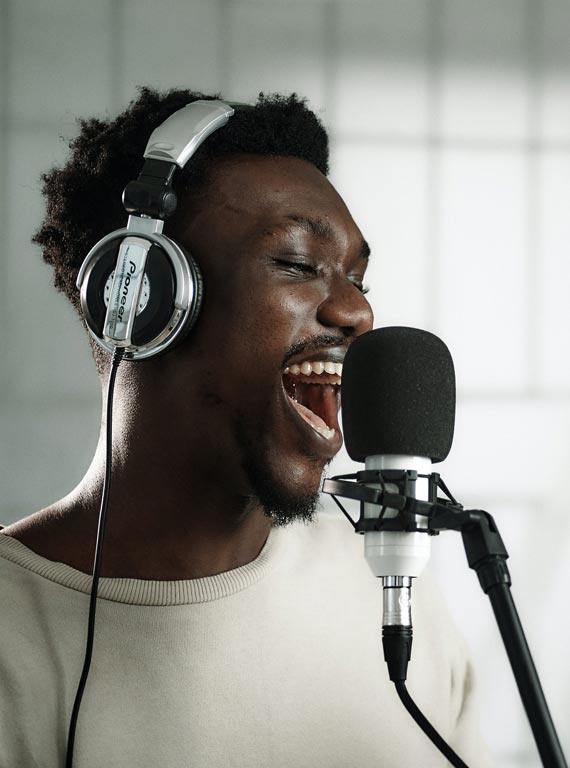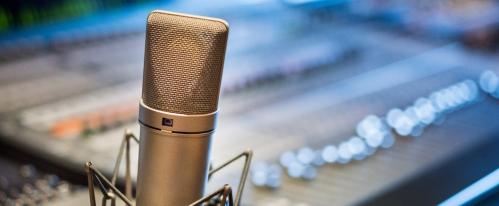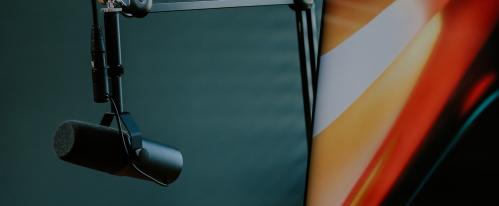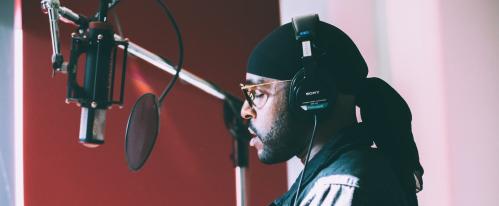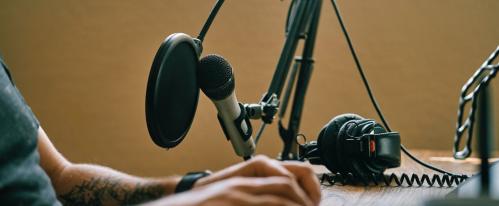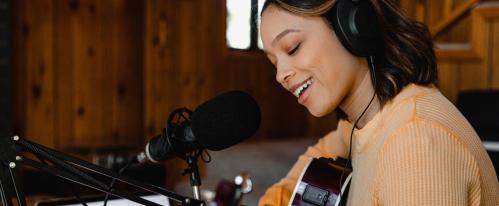We highlight some of the best mics for voice-over recording, narration, and dialogue to get the best sound possible for spoken-word performance
When you’re looking for the best mics for voice-over recording, voice acting, narrating, and dialogue, there are many options open to you depending on what you’re using them for. Fortunately, you’re only really limited by two things – budget and equipment.
Budget
The budget side of things is not necessarily a deal-breaker as you can get a fantastic quality voice-over microphone to suit almost any budget -but as always a higher price tag often means higher-quality parts, greater sensitivity, and longevity.
Equipment
In terms of equipment, you’ll need to think about whether you want to purchase additional audio interfaces or simply want to plug your microphone into your PC, laptop, tablet or phone to record audio. With this considered, we’ll break out into two categories – USB microphones for voice-over and XLR microphones for voice-over recording.
Here’s a quick explanation..
Help me to choose between USB and XLR mics for voice-over recording, narration and voice acting..
When you’re thinking of choosing your microphone for voice acting or voice-over recording, you need to decide whether you want a USB microphone or an XLR microphone - this will either keep you within budget or increase your budget depending on what gear you have to hand. Let’s explain..
Should I use XLR microphones for voice-over recording, narration and dialogue?
Yes, if you have an audio interface and don’t mind carrying extra equipment with you when you travel.
XLR microphones are the “regular” style of microphones with a 3-pin connection you’re likely familiar with. To achieve the connection, you’ll need an audio interface with an XLR port. This poses an issue for some voice actors or voice-over recording artists as they now have to buy an audio interface to go along with their microphone. If you’re on a tight budget and you’ve spent all your money on the best voice acting microphone you can afford, you’re potentially running over-budget.
An audio interface allows you to power the microphone if it needs phantom power, add gain, and manipulate volume and other settings. It also gives you somewhere to plug-in headphones – and yes, you also need to choose some headphones!
If you don’t already have an audio interface, then we highly recommend a USB microphone to keep costs down.
Choose an XLR mic for voice over and narration if you:
- Have an audio interface
- Don’t mind carrying extra gear with you
- Want a higher-end microphone
- Want to broadcast on radio
- Need a microphone for Foley
Should I use USB microphones for voice-over recording and narration?
Yes, if you don’t have an audio interface and want something portable to record sound with.
USB microphones plug directly into your USB port on your computer. Your PC or laptop will power the microphone and provide the connection to your DAW (recording software) rather than through an audio interface. USB microphones will often give you control over volume, gain, and a headphone connection built directly into the microphone. This is especially handy if you’re a travelling YouTube Vlogger looking for a microphone, or you broadcast from remote locations and you want to keep your equipment to a minimum.
Choose a USB mic for voice over and narration if you:
- Have a reliable computer
- Need minimal equipment for setting up and pack down
- Don’t want to learn how to use an audio interface
What is the Best Microphone for Voice-Over? USB or XLR?
If you want more choice, more control and the ability to plug your mic into any studio console, XLR is best. USB is best for those who want to plug into their own laptop or those who have a highly-portable option for field recording and interviews.
Choose between voice-over recording, narration or voice acting microphones..
If you’re aiming to record high-quality dialogue, then you’ll want a mic to suit 3 quite different purposes such as:
- Voice acting
- Narration
- Voice-Over
Microphones for Voice Acting
Voice acting will potentially require you to create different voices and vocal characteristics spanning both low and high notes, so you’ll need a microphone that can handle a lot of different frequencies and volumes. You may be pretending to be a cartoon squirrel with a high-pitched voice one day, then a very serious private detective for a radio play the next. With that in mind, you’ll need a microphone with a wide frequency range to handle the low-end as well as the high-pitched treble sounds whilst retaining detail.
Microphones for Narration or Voice-Over
Narration and voice-over work will often require a wide frequency range too, but with an emphasis on the low-end to add more presence. If you need a microphone for audiobook recording, you’re best with a microphone that has an emphasis on the low-end frequency as this really brings out the “weight” and presence in your voice whilst rolling off the high-end frequencies. However, if you already have a low voice, you’ll want something like the industry-standard Shure SM7B with a bass roll-off that reduces the unwanted proximity effect and bass. You want the power without the unwanted boom!
What is the industry standard voice-over microphone?
Condenser or high-end dynamic microphones are widely considered the industry standard for voice acting, narration and voice-over work. They make your recordings sound “alive” which is what you need to make your dialogue pleasant on the ear.
The Best Mics for voice-over recording, narration, and dialogue..
Here we’ll highlight some of the industry-standard microphones for voice-over recording, narration, and dialogue - as well as some newcomers to the scene which we can comfortably recommend. These microphones will span a range of budgets, and we’ll let you know what type of audio recording they’re best for - taking into account frequency, sensitivity, self-noise, and SPL.
Shure SM7B Dynamic Studio Microphone
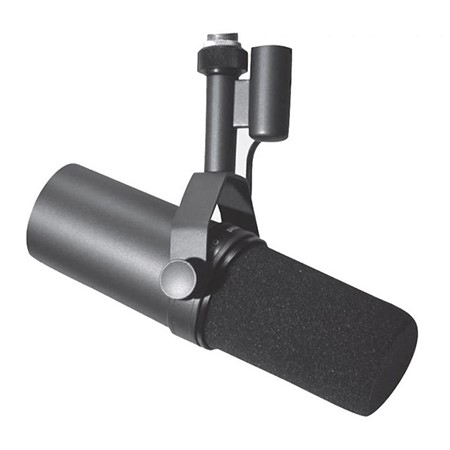
Run far away from any “best mics for voice over recording” list without the Shure SM7B in. Although condenser microphones are often considered the “better” option due to the amount of sensitivity on offer, the Shure SM7B has widely become the industry standard voice-over, podcast and narration microphone, as well as the best option for voice acting for those who want studio-quality sound at a mid-level budget.
One of the major reasons we recommend the Shure SM7B (and a key reasons EVERYONE uses it), is the fact they provide smooth vocal reproduction with a bass roll-off feature. This means you can get close to the mic without the “boominess” creeping in or proximity effect causing havoc - this is ideal for audiobooks and narration.
The 50 Hz – 20 kHz frequency response makes it perfect for all types of voice-over work and can handle a wide range of vocal performances. The handy bass roll-off and mid-range emphasis (presence boost) control on the rear of the mic allow you to make subtle, yet important changes to the frequency when recording. If you’re recording audiobooks, set it to flat. If you’re voice acting, hit the bass roll-off – it’s that simple.
The included pop filter stops plosives from creeping in and the classic cardioid polar pattern effectively rejects unwanted off-axis noise.
If you want crystal clear sound, high SPL (so you can shout as loud as you want), complete control over your frequency response, and a microphone that’ll last decades, the Shure SM7B is a perfect choice for voice-over artists, voice acting and narration. At way under £400, you’re not blowing the bank, just blowing minds with how awesome your vocals sound!
So is the SM7B good for voice over?
Absolutely. The wide frequency range allows you to capture all nuances of your performance, the included pop shield stops plosives, and the ability to manipulate frequency response via switches on the mic which allow you to change the mic depending on your voice or vocal performance style.
3 reasons why we like it:
- 3 different controls to cut low/high frequencies
- Pop Shield included
- Incredible off-axis rejection
Check out our blog on Why the SM7B is So Popular here.
Is the Shure SM7B better suited to voice acting, dialogue or narration?
All of the above!
Lewitt LCT 840 Tube Condenser Microphone
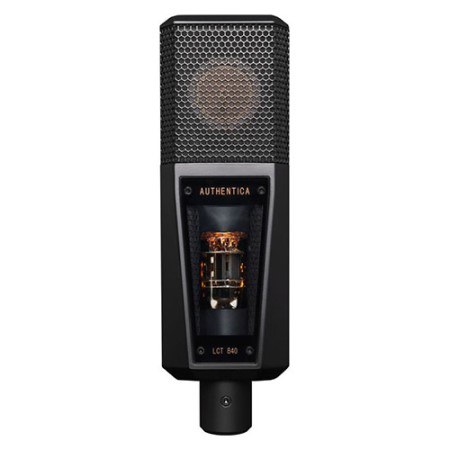
Next up we have the Lewitt LCT 840 Tube Condenser Microphone, which offers incredibly immersive vocal reproduction thanks to tube technology. For those that don’t know, tube amps and mics use vacuum tubes to increase the amplitude or power of a signal. This provides a relatively warmer, more immersive experience with plenty of dynamics. This means you have a more “in the room” sound and the mic responds beautifully to the dynamics of your voice, offering natural compression and warmth.
Some people feel that they do a great job of capturing very subtle nuances due to the detail they pick up – worth considering if you’re a voice actor or narrator.
We think it’s a great mic for voice-over work and voice acting as the 20 - 20,000 Hz frequency response allows for a wide-variety of dynamic vocal performances. The extremely low self-noise of 9dB means you have silence between delivery and the SPL of 130dB means you can record at all volumes.
One of the key benefits of this mic is the ability to switch between 5 different polar patterns: Omni, wide cardioid, cardioid, supercardioid, and figure-8. You can also do this remotely via the included amplifier. This is perfect for those who are recording at home and need to control their mic without walking over to their computer!
A great mic that provides incredibly immersive sonic qualities allowing you to achieve that “voice of god” sound that broadcasters and narrators love.
3 reasons why we like it:
- 5 different polar patterns
- Dynamic tube saturation adds warmth
- Wide frequency range
Is the Lewitt LCT 840 Tube Condenser Microphone better suited to voice acting, dialogue or narration?
All of the above!
AKG C414 XL2 Condenser Microphone
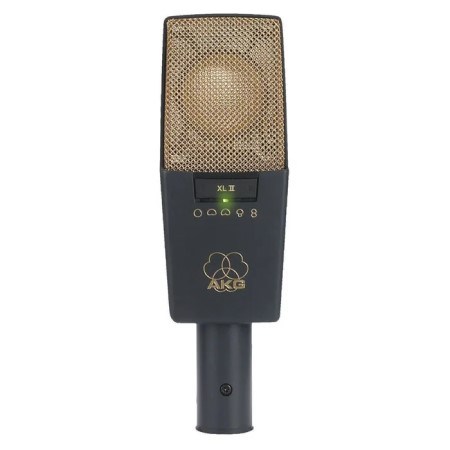
If you’re a voice-over artist, voice actor, narrator, or audiobook artist who wants to create Foley soundtracks to go along with their dialogue, then the AKG C414 XL2 Condenser Microphone is ideal. It’s essentially 5 different microphones in 1 almost indestructible unit.
Straight out of the box you get Cardioid, Figure of Eight, Hypercardioid, Omnidirectional, and Wide Cardioid polar patterns to play with, allowing you to record vocals one day, then guitars, footsteps and room ambience another. There’s not a lot this mic can’t do!
The 20 - 20000 Hz frequency allows for a wide dynamic range and the ability to cut the bass in 3 different stages: 160; 80; 40 Hz provides optimal control if you have a particularly deep voice, or you’re recording whispered vocals and need to reduce the proximity effect
The 6-dB self-noise means it’s silent between takes – essential for audiobook dialogue. The three attenuation levels (-6/-12/-18dB) allow for close-up recording or high-output sources of up to 158dB SPL and the overload warning tells you via an LED when you’re too loud.
A great voice over mic for those who are just starting out and experimenting with their vocal delivery.
3 reasons why we like it:
- 5 different polar patterns
- LED tells you when you’re too loud
- 3 stages of bass attenuation help with proximity effect reduction
Is the AKG C414 XL2 Condenser Microphone better suited to voice acting, dialogue or narration?
All of the above!
Shure KSM32/SL Cardioid Condenser Microphone
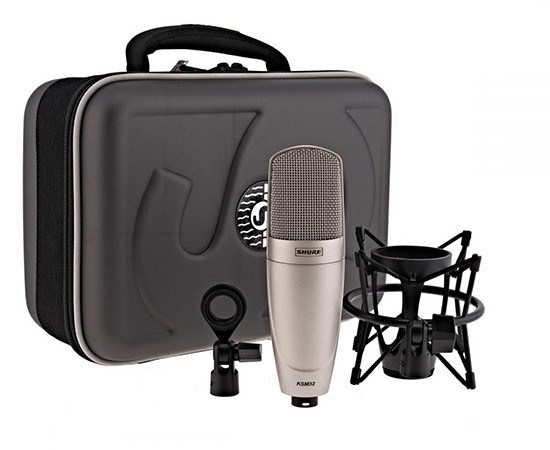
When you need a full, flat frequency range that captures detail at all ends of the sonic spectrum, the Shure KSM32/SL Cardioid Condenser Microphone is ideal.
We love this mic, and think it's one of the best voice-over and voice acting microphones thanks to its flat frequency range of 20 Hz - 20 kHz. This makes it ideal for voice acting as you can ensure you have intricate detail whether you’re whispering, building tension with a low voice or excitedly chatting away with a higher voice.
This is one of the best mics for voice actors as the switchable low-frequency filter allows you to reduce background noise and the proximity effect – ideal for those with home studios! The ultra-thin 24-karat gold-layered Mylar diaphragm provides superior response, meaning the most intricate of vocal nuances will appear in your recording, making it a great option for character actors.
Best of all you have a three-stage pop protection grille built-in, which effectively reduces unwanted "pops" and breath noise from creeping in, while the internal shock mount not only reduces mechanical handling noise but protects the capsule while you move it around in its included case. Best of all, you have a cradle included so you never have to worry about knocks or bumps making it into your recordings.
The max SPL of 139dB allows you to record loud vocals and the 15dB pad enables volume attenuation for when it gets REALLY loud in the studio.
At around £500 it won’t blow your budget, but will easily push your vocal performance into the professional realm of voice acting.
3 reasons why we like it:
- Extremely sensitive diaphragm captures detail
- Wide frequency response
- 3 stage pop filter reduces unwanted plosives and breath
Is the Shure KSM32/SL Cardioid Condenser Microphone better suited to voice acting, dialogue or narration?
All of the above
Antelope Audio Edge Solo Condenser Modelling Microphone
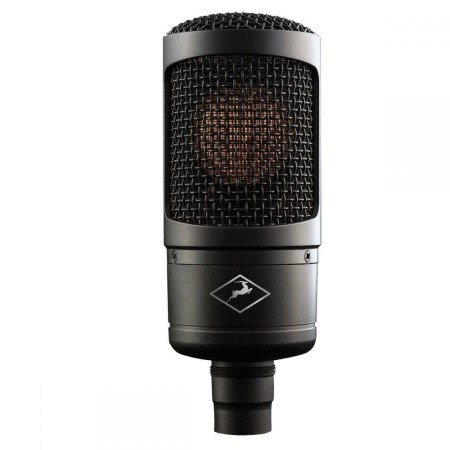
Mic emulation is a great way of beefing up your studio microphone collection without having to buy a load of different microphones. You might prefer the warmth of a ribbon mic one day, or the cool, flat response of a dynamic the other. The Antelope Audio Edge Solo Condenser Modelling Microphone allows you to effectively emulate the sound of 18 different microphones – all for around £300! This is essentially the same as buying 18 different microphones!
We think this is a great option for voice actors and narrators as this single-capsule large-diaphragm condenser mic allows you to capture vintage sonic qualities – ideal for those horror film voiceovers, or relatively new, cleaner options.
The cardioid polar pattern effectively rejects off-axis noise and the 20HZ 20kHZ frequency response allows you to record all manner of vocal performances.
The gold-sputtered capsule is extremely sensitive, so all nuances of your performance will be picked up and the low self-noise of 19dB makes it great for voice acting. However, there are other, quieter options for narration.
If you want to emulate the tonality of iconic and modern-day microphones and produce beautifully sounding vocals for all kinds of dialogue recording, this is a great option for the sonic connoisseurs out there.
3 reasons why we like it:
- 18 microphone emulations built-in
- Wide frequency response
- A very sensitive capsule captures subtle nuances
Is the Antelope Audio Edge Solo Condenser Modelling Microphone better suited to voice acting, dialogue or narration?
Voice acting
Voice-over work
Shure MV7 USB Podcast Microphone
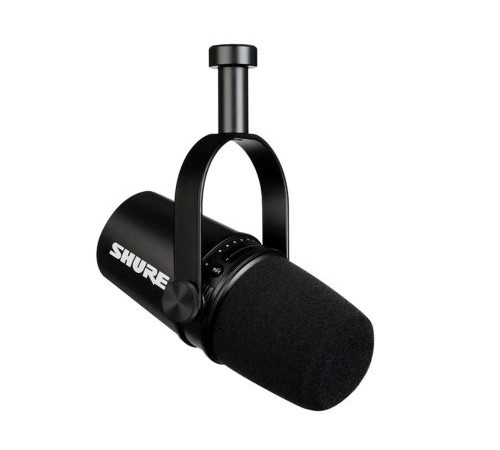
If you can’t quite stretch your budget to a Shure SM7B, then the Shure MV7 USB Podcast Microphone is the logical net level providing incredibly detailed sonic performance at a budget we can all afford.
One of the key reasons we love the Shure MV7 USB Podcast Microphone is the fact you have dual USB/XLR connectivity which allows for digital or analogue recording. You can use your audio interface, or simply plug it directly into your computer and start recording with the ShurePlus MOTIV Desktop Application for access to audio processing.
This is a plug and play voice acting microphone for those who don’t really know how to (or want to learn how to) manipulate audio via an audio interface.
The built-in touch panel gives you controls for gain, monitoring volume, headphone mix, and mic muting, which is especially useful if you don’t want to walk to your workstation or laptop every time you want to make an adjustment.
The built-in headphone output allows for direct headphone monitoring while recording, making it a great option for those who have portable studios – there’s no need for a headphone amp or audio interface!
The frequency response is a little more limited than some of the other mics in this list, clocking in at 50 Hz to 16,000 Hz, so it’s better suited to narration, audiobook or voice-over work where you need to record adverts or radio promotions. Voice actors may not appreciate the lack of response at the lower or high end of the spectrum.
However, what this lacks in sensitivity, it more than makes up for in audio conversion. The A/D Converter allows for 16 or 24-bit, 44.1 or 48 kHz conversion, which is ideal for internet radio adverts, broadcasting and audiobook narration providing exceptional quality for just over £200. You’ll find it hard to find digital audio quality this good at this price range!
3 reasons why we like it:
- A/D Converter allows for 16 or 24-bit, 44.1 or 48 kHz conversion
- Pop filter included
- Dual USB/XLR output
Is the Shure MV7 USB Podcast Microphone better suited to voice acting, dialogue or narration?
- Narration
- Voice-over work
- Dialogue
AKG C214 Condenser Microphone
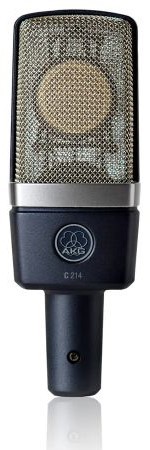
The AKG C214 Condenser Microphone is a perfect alternative for those who want the high-end, industry-leading C414 sonic quality, but can’t quite stretch the budget.
This offers a wide frequency bandwidth of 20 - 20000 Hz, so you’re covered for all types of audio production. The cardioid polar pattern rejects the unwanted off-axis noise and the -20dB attenuation pad allows you to drop the mic volume when you’re recording louder sessions.
We also love it as the bass-cut filter allows you to cut the low end by 160 Hz, effectively reducing the unwanted boom and proximity effect without killing the detail.
This is a budget-friendly, professional level, large-diaphragm condenser microphone that won’t break the bank. It’s fairly no-frills, and one of the best microphones for voice over, narration and voice acting.
3 reasons why we like it:
- Wide frequency response
- Low-end cut
- Based on industry-leading C414 microphone
Is the AKG C214 Condenser Microphone better suited to voice acting, dialogue or narration?
All of the above
Shure BETA 27 Instrument Condenser Microphone
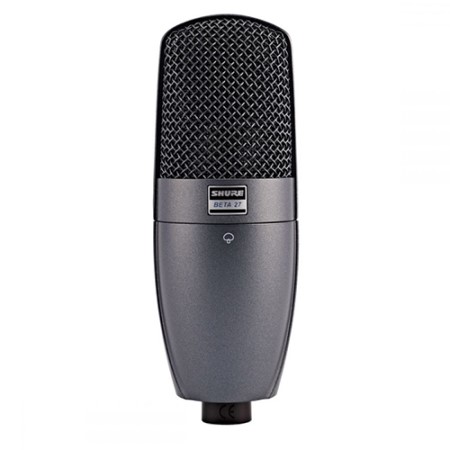
Last but not least, we have the Shure BETA 27 Instrument Condenser Microphone. This is predominantly known as an instrument microphone, however, there are a few key features that make this one of the best voice over mics on the planet.
The Shure BETA 27 Instrument Condenser Microphone has an uncanny ability to capture the sonic qualities of your voice (or any instrument) without adding colour to the sound. This means your vocal delivery will be accurately represented.
This is a perfect microphone for voice-over and voice acting, especially for those with lower voices as the integrated 3-position LF switch allows you to tame the unwanted bass frequencies and remove the proximity effect – a great tool for those with a full vocal range!
You have superior transient response thanks to the low-mass gold layered diaphragm, enabling you to safely record explosive emotion (a shout or sharp snare sound) at a moment's notice. Go from cool and calm to unwieldy emotion and listen as the microphone responds beautifully!
Finally, the supercardioid pickup as opposed to cardioid delivers a more controlled sound and stricter off-axis rejection ensuring you record everything you need to and nothing you don’t.
If you care about your vocal performance, have a particularly animated delivery and need a mic that can withstand decades of use, this microphone is perfect.
3 reasons why we like it:
- Wide frequency response
- Supercardioid polar pattern
- Integrated 3-position LF switch removes the proximity effect
Is the Shure BETA 27 Instrument Condenser Microphone better suited to voice acting, dialogue or narration?
All of the above
Final Thoughts..
We hope you enjoyed our best voice acting mics article. Let us know in the comments below if you have any recording tips on how to get the best out of your narration, or vocal delivery!
Need some extra help choosing studio microphones for voice-overs or voice acting? Do you need to speak to someone about creating a home studio or improving your recording quality with better microphones? Call us on 0151 448 2089 or check out your local store to speak to one of our Experts about your microphone and recording needs.

